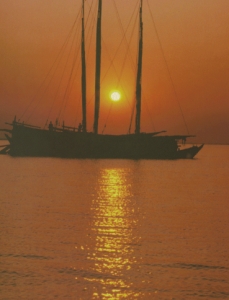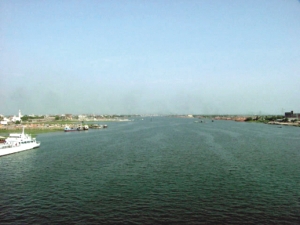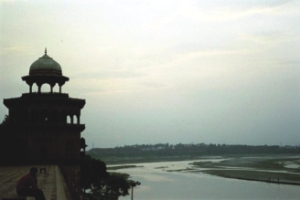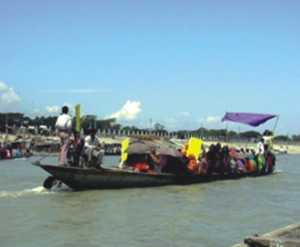|
Heritage
The Enduring Flow of Myth and Mysticism
Abdul Awal Mintoo
 The Jamuna is one of the biggest Himalayan Rivers, known as Brahmaputra in India and as Tsang Po further in Tibet. It stretches to about 2500 km long and the mighty river practically drains out half of the Himalayan drainage from both the northern and southern sides. The river remained untamed because massive volumes of water carried by this river and its wayward impacts have been uncontrollable, despite advanced technological interventions. So far, no dam could be constructed over this meandering river due to unexplored and unknown deep gorges which no human being could penetrate. Only two bridges have been successfully built for river-crossing; the first one is in a place near Gauhati, Assam and latter one is in Bangladesh, connecting the northern and southern parts of the country. The river poses various types of challenges at different places to explorers and adventurers. The Jamuna is one of the biggest Himalayan Rivers, known as Brahmaputra in India and as Tsang Po further in Tibet. It stretches to about 2500 km long and the mighty river practically drains out half of the Himalayan drainage from both the northern and southern sides. The river remained untamed because massive volumes of water carried by this river and its wayward impacts have been uncontrollable, despite advanced technological interventions. So far, no dam could be constructed over this meandering river due to unexplored and unknown deep gorges which no human being could penetrate. Only two bridges have been successfully built for river-crossing; the first one is in a place near Gauhati, Assam and latter one is in Bangladesh, connecting the northern and southern parts of the country. The river poses various types of challenges at different places to explorers and adventurers.
As late as 1912, the source of Jamuna had remained a great 'mystery' to surveyors and geographers. The mystery was compounded by a belief shared by millions of people that somewhere between China and India, there is a mountain endowed with cosmic energy. This mountain is said to be the nerve centre of the earth and the axis of the universe and from its summit flows a mighty river that falls into a lake which is divided and re-united to form one of the greatest rivers in Asia. This mountain is revered by many millions of Hindus, Buddhists and Jains as home of their gods.
Research findings to solve the 'Mystery of Jamuna' corroborated the Hindu belief that the source of this mighty river was from the 'abode of snow' of Himvant (Himalaya) and according to the Mahabharata the Meru Parbat, which means it gives the heaven its height. On the Meru's summit covered with heavenly white snow lies the 'Swarga' (The Heaven). It is believed to be the seat of 'INDRA'- the god of 'Rain and Storm'
The source of the Jamuna was found to be the glaciers at a height of 22,300 ft in the body of Mount Kailash, from where water flows Southeast to the Himalayan lake Mansaravar. The lake is also considered to be the holiest in the world by Hindus, Buddhists and Jains. After originating in the South of Kailash, it takes the name Tsangpo' and runs almost directly eastward and passes through the Tibetan Plateau upto the town of PE, China. Then it takes a sharp turn towards the south, takes the name "Ya-lu Tsangpo Chiang" and runs between the magnificent peaks of Gyalaperi (23,462 ft) and Namchabarwa (25,447 ft). The river then flows downwards and drops in a series of rapids and cascading water falls, cutting across the great Himalayan ranges and mountain passes along the deep "Tsangpo Gorges" and enters India near Gelling (Mac-Mohan line).
From Gelling the river takes it's name 'Dhiang' and drops further through a series of rapids, cascades and gorges up to Passighat in upper region of Assam. It is a racing torrent when it comes from the Tsangpo Gorges with thundering masses of water as it churns its way through a series of gorges at a breathtaking speed to reach Passighat. At Passighat, the river turns to the west, takes its new name "Brahmaputra" and runs through Assam Valley and enters into Bangladesh at Noon Khawa at Kurigram (Dhubri on Indian side).
 Upon entering into Bangladesh at Noon Khawa, the river flows southwards. At a point South of Gaibandha near Phulchari, the old Brahmaputra branches out of the mainstream from the left bank and flows past Jamalpur and Mymensingh to join the Meghna River at Bhairab. From Phulchari, 'Brahmaputra' takes its new name "Jamuna" and continues southwards up to Gualondo, where it forms a confluence with the Padma (Ganges). From Gualondo, the river takes it's new name "Padma" and continues with that name South Eastwards up to Chandpur where it forms a confluence with the Meghna. From Chandpur, the river again changes to its new identify, the 'Meghna' and flows straight southwards until enters the Bay of Bengal through the Meghna estuary and other minor channels. Upon entering into Bangladesh at Noon Khawa, the river flows southwards. At a point South of Gaibandha near Phulchari, the old Brahmaputra branches out of the mainstream from the left bank and flows past Jamalpur and Mymensingh to join the Meghna River at Bhairab. From Phulchari, 'Brahmaputra' takes its new name "Jamuna" and continues southwards up to Gualondo, where it forms a confluence with the Padma (Ganges). From Gualondo, the river takes it's new name "Padma" and continues with that name South Eastwards up to Chandpur where it forms a confluence with the Meghna. From Chandpur, the river again changes to its new identify, the 'Meghna' and flows straight southwards until enters the Bay of Bengal through the Meghna estuary and other minor channels.
The combined flow of the river drains out most of the Himalayan downpour from north (through Ganges/Padma) and south (through Tsangpo/Brahmaputra). The river is 8-10 km wide all along from Assam until it falls into the Bay of Bengal. The river has carved out thousands of channels and created just as many sandy shoals (chars) through its course.
In late autumn, when people living on shoals of Jamuna retire at night, the moonlight engulfs the tiny sandy shoals with its silver veil illuminating the sand, while a gentle breeze sings a lullaby. As the night progresses, the moon seems to become one with the river and all our senses are attuned to a cosmic silence that surrounds the river by a supernatural ambience. In these surroundings, one can only feel the rhythm of eternal life gently guide human existence. It gives solace to those who may be searching for a profound meaning of life. At the break of dawn the caress of morning breeze brings delight to its inhabitants.
On a dew-drenched Baishakh morning, hundreds of migratory birds of many colours, fly soaring with the clouds and the newly-emerged shoals become their sanctuary. The river banks of Jamuna are fertile and host many different crops; amongst them are paddy, maize, kaun, jute, sugarcane, potato, pulses, mustard and seasonal fruits. Vegetable fields are harvested throughout the year.
As the inhabitants come out of their homes sometimes they stroll along the bank and reminisce about their lives, the past and present. Sometimes as they sit idly on the bank and enjoy the clear water streaming down the river. They may even experience the illusion that the river-flow is constant but they themselves are moving. People are enthralled by the mesmerising beauty and the captivating variety of daily activities surrounding the river.
Boats and other water transports are always afloat on the river while lines of fishing boats move about leisurely. Some carry sand and shingles, while others are crisscrossing the river to ferry people. Thousands eke out a living from this long river.
 Throughout the day, waves continue to break on the bank. Golden sun rays fall on broken waves like fire on a bronze plate. Throughout the day, waves continue to break on the bank. Golden sun rays fall on broken waves like fire on a bronze plate.
At sunrise and sunset, the river ghats (small jetties) remain very busy due to the activities of thousands of boats. Many inhabitants living on the shoals of Jamuna have to travel daily to towns on the bank for work. After a hard day's work, they bring with them all types of consumables for the family.
Many busy ghats of today may disappear tomorrow by the stealthy river erosion and a new ghat would soon evolve nearby. Such shiftinglanscape is a way of life for the Jamuna basin, which has been through constant changes over thousands of years.
Jamuna is a quiet river, but it cannot always be predicted; sometimes the rain-fed river bursts the banks and thousands of people are displaced from their regular homes. At times, the river goes on a rampage, leaving a trail of destruction in its wake. In a matter of days, its eroding jaws devour century-old bequests of civilisation. At the same time, its calmer flows brings silts for accretion from other banks from upstream and helps build new villages, bazaars and crop-fields.
It would be unfair to say that the Jamuna is destructive or savage. If it destroys villages,  it eventually forms more land to build new villages. To a great extent, Bangladesh owes its trademark of its green expanse to the Jamuna. It can be termed as the lifeline of Bangladesh because it flows through the middle of the country, all the way from the north to the south. For millions of people, the river is their livelihood. it eventually forms more land to build new villages. To a great extent, Bangladesh owes its trademark of its green expanse to the Jamuna. It can be termed as the lifeline of Bangladesh because it flows through the middle of the country, all the way from the north to the south. For millions of people, the river is their livelihood.
Jamuna changes its character with seasons, it is dramatically different during the summer and in the rainy season. In summer, the river is quiet, while in the rainy season, it is ferocious and assumes huge proportions. In autumn, the Jamuna calms down and is gracefully poised as it bathes in soft moonlight and in the winter, it is somber in dew and fog. Indeed it is mysterious in its ways.
The Jamuna holds myriad characteristics, on account of the geographical variation of the long route of its course in the three stages of its origin to estuary. In some places, the river is inaccessible due to mountainous terrain, while in the plain, it is easily accessible to people. That is why villages, marts, towns, ports and civilisations have evolved around this mighty river. It has become an integral and vital part of the lives of a great number of people in Bangladesh and elsewhere.
Copyright
(R) thedailystar.net 2005 |
